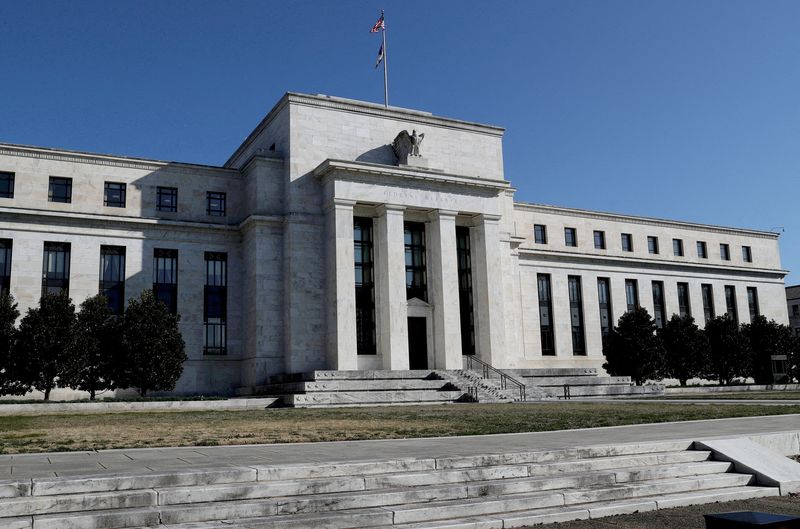As Fed meeting looms, economists see central bank balance sheet in new light
2023.03.22 06:39

© Reuters. FILE PHOTO: The Federal Reserve building is pictured in Washington, U.S., on March 19, 2019. REUTERS/Leah Millis/File Photo
By Michael S. Derby
WASHINGTON (Reuters) – Historic Federal Reserve lending to banks in the wake of Silicon Valley Bank’s collapse punched a huge hole in its effort to shrink the size of its balance sheet, though economists don’t view that turnaround as a shift back toward a stimulative use of its asset stockpile.
Instead, the rapid expansion of the Fed’s holdings of cash and bonds has emerged as a key tool to help contain financial stability issues, speaking to the core mission of why the central bank was founded just over a century ago.
The usage of these lending facilities, including the Fed’s long-shunned discount window for bank lending, gave the central bank room, should it choose it, to press forward with rate rises and avoid past cycles of being forced to stand aside or cut rates when markets suffer notable turbulence.
While the Fed may have underestimated how rate rises and its bank oversight would affect the financial system, “in one way they were remarkably prescient — the Fed has been trying to institutionalize reforms to the discount window designed to improve financial stability in the aftermath of the early-COVID financial crisis,” wrote Joseph Politano, of Apricitas Economics, in a newsletter Saturday. The “unprecedented use of the discount window partially reflects the desired results of those reforms.”
Evercore ISI analysts pointed to the seeming contradiction of an expanded balance sheet driven by financial stability concerns happening as monetary policy tightens, and noted there is “rarely a perfect separation between financial stability and monetary policy goals. Messy real world policymaking needs to embrace this.”
BIG NUMBERS
Fed numbers showed the speed of the shift to a new balance sheet reality. Last Thursday, Fed data showed a massive surge in lending to banks, driven notably by $153 billion in what’s called discount window credit, up from $5 billion the week before and blazing through a record set in the fall of 2008, when the financial crisis pushed banks to take $112 billion.
That borrowing, which also saw other large-size Fed credit extensions, pushed the size of the Fed’s overall balance sheet up to $8.7 trillion on Wednesday, versus $8.4 trillion the week before. Fed holdings peaked at just shy of $9 trillion last summer.
On the face of it, the emergency borrowing unraveled months of progress in which the Fed allowed some of the Treasury and mortgage securities it owns to expire each month. This effort, known in markets as quantitative tightening, or QT, complemented the Fed’s aggressive rate rises aimed at bringing down inflation.
That puts the central bank in a seemingly awkward position. While the banking sector’s woes have generated considerable uncertainty into the outcome of the rate-setting Federal Open Market Committee meeting which concludes Wednesday, the Fed nevertheless appears on track for another quarter point rate rise.
The details of Fed holdings matters greatly in terms of understanding Fed balance sheet dynamics, analysts say.
Benson Durham, head of global policy at Piper Sandler, said the key is the composition and not the size of Fed holdings. Emergency borrowing has driven up the overall level of Fed holdings, but the Fed continues to shed bonds and cut the level of reserves in the banking system, which is how the QT process has worked all along, he said.
Even with a jump in the balance sheet the Fed is “still credit tightening” and when it comes to the increase in the overall size, “it’s hard for me to imagine that this is remotely inflationary,” Durham said.
Tim Duy, chief U.S. economist with SGH Global Advisors, agreed and said the Fed emergency lending is “not funding that’s going into banks that they can make loans with per se,” a key factor blunting any form of new stimulus.
There’s even a case for how some of the underlying factors driving banks to borrow Fed cash point to the tighter financial conditions the central bank has sought to control inflation, and which could hamper growth.
Matthew Luzzetti, chief U.S. economist at Deutsche Bank (ETR:) Securities, said “a tightening of bank lending conditions could lead to a broader tightening of financial conditions that would meaningfully dent growth prospects and heighten recession probabilities.”
LESS ROOM TO RUN?
One factor limiting economists’ interpretation of the balance sheet surge is the fluidity of the factors now driving it.
“At this early stage in the process, it is unclear how much of the Fed’s emergency lending will turn out to be sticky,” analysts at Wrightson ICAP (LON:) said in a note over the weekend.
But even with that caveat, the firm saw some potential implications for how the Fed proceeds with its balance sheet drawdown, depending on banks’ reserve positions. Even if, as expected, the FOMC decides at the meeting to keep the drawdown at its current pace of $100 billion per month, it may allow the drawdown to end earlier than previously expected.
There’s little doubt banks’ demand for reserves has risen amid more fragile conditions, the note said. “If some of the recent surge in emergency lending runs off in the weeks ahead, it may very well be the case that this episode has nudged the banking system closer to the point of effective reserve scarcity rather than farther away.”








